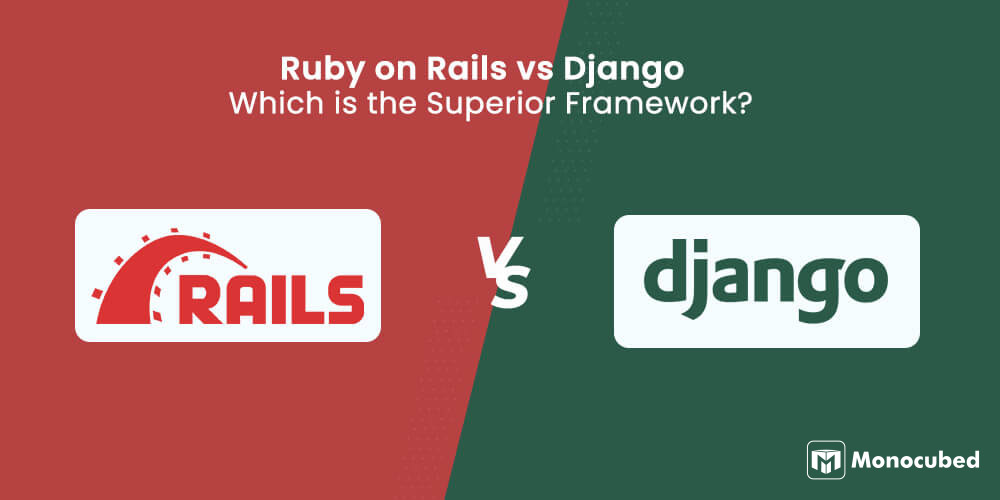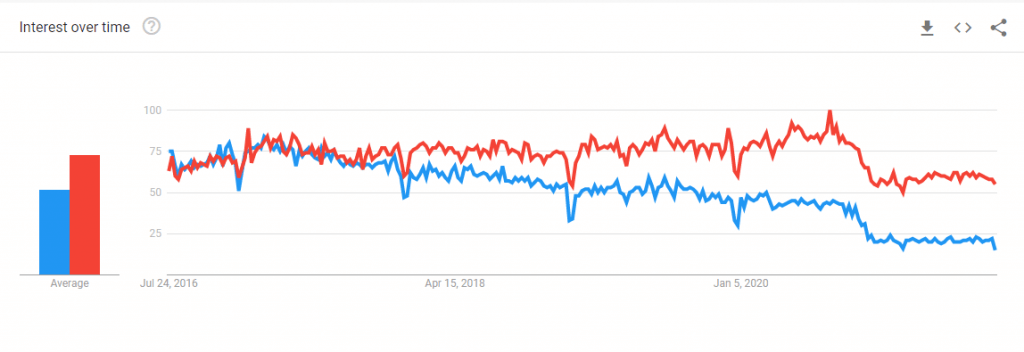Wondering how to choose between Ruby on Rails and Django? We have curated a quick list to help you choose the right framework for backend development.
Use Ruby on Rails if your project requires the following.
- Quick MVP development
- Rapid prototypes
- Safe and secure eCommerce web apps
- Simple to use and highly productive
- Scalable websites that you can update in real-time
Use Django if your project requires the following.
- Modern web apps with ML and AI features
- Scientific and mathematical programming
- Highly secure websites
- Handling huge database
- Large development team
Want to know more about RoR and Django?
In this Ruby on Rails VS Django blog, we will be exploring some of the major differences between two of the most popular backend frameworks. Both Ruby on Rails and Django simplify the complex development process of data-driven, high-traffic websites.
We will look at some of the features of Rails and Django and also provide a detailed guide on when and where to use these frameworks.
Table of Content
Rails vs Django – Quick Comparison Table
Let’s take a quick look at this Django and Ruby on Rails comparison table that discusses the major differences between the two frameworks.
| Ruby on Rails | Django | |
|---|---|---|
Language |
Ruby on Rails is based on the Ruby programming language | Django is a Python-based web framework |
License |
BSD License | MIT license |
Design Architecture |
Rails follows Model-View-Controller or MVC architecture | Django follows Model-View-Template or MVT design |
Speed |
Ruby on Rails is faster than Django | Django is slower than RoR by 0.7 percent. |
Philosophy |
“Convention over Configuration” “Progress over stability” “Don’t Repeat Yourself” | “Explicit is better than implicit” “Don’t Repeat Yourself” “Loose coupling, tight cohesion” |
Learning Curve |
Has a smooth learning curve | Is tougher to start using Django with its steep learning curve |
Flexibility |
Rails provides flexibility to developers to be innovative. | Django is very opinionated. Offers very little flexibility compared to Rails. |
Usage in Web Development |
Used for MVPs and eCommerce projects | Preferred for developing data-heavy websites |
Other Usage |
Rails is mainly used for web projects and meta programming | Used for Machine learning, Data Science, and Artificial Intelligence projects |
Community support |
Rails has a small community of dedicated developers | Django is much more popular and has a very active community |
Examples |
Some popular websites built with Rails are Shopify, GitHub, and Netflix | Some examples of popular Django websites are Youtube, Dropbox and Disqus |
Now that we know the differences, let’s look at each framework in detail to understand their strengths and limitations more clearly.
What is Ruby on Rails?
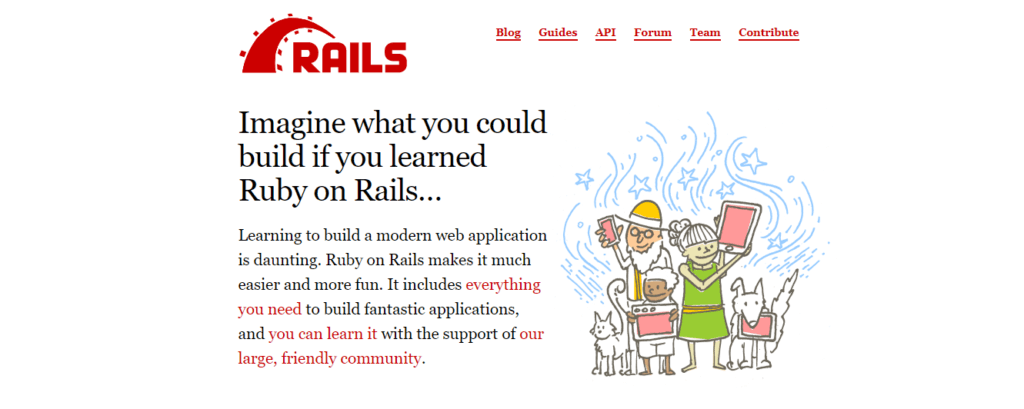
Ruby on Rails is an open-source framework used for developing server-side web applications. Many startups prefer Ruby on Rails, as it is ideal for the rapid development of prototypes and Minimum Viable Products(MVPs).
It operates on the MVC (Model-View-Controller) architecture. MVC is considered to be the best design principle as it effortlessly separates business logic from the database, queries, and UI-UX code.
When RoR was first introduced in 2005, it brought new and unique features to the web developing world. With Conventions over configuration(CoC) ideology, Rails brought in a completely fresh way of building web applications.
By implementing the CoC software design paradigm, Rails provides web developers with a tool that significantly reduces coding time. It eliminates the need to write boilerplate code.
Want to Test Your Web App Idea?
Validate your idea with our professionals. Develop a quick MVP to test your web app idea using Ruby on Rails.
What is Django?
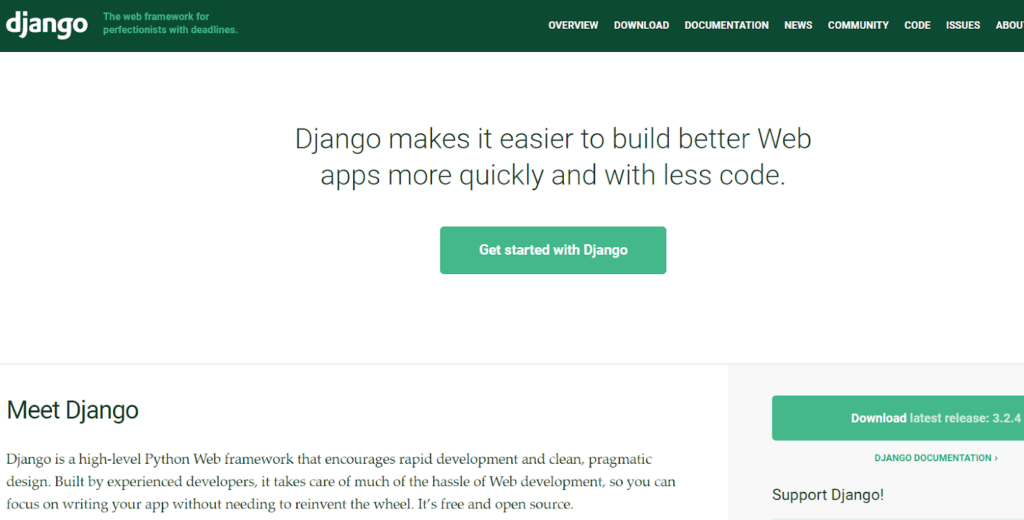
Django is a full-stack web framework used for developing robust, large-scale web apps and websites. It follows the object-oriented paradigm and is generally known as ‘the framework for perfectionists’.
It is a general-purpose, open-source, and free framework, making it easily accessible. Based on the Python programming language, Django extends all the philosophies of Python to provide a pragmatic, simple, and portable platform for developers.
Features of Django are highly praised by developers. It was designed with the purpose of simplifying the process of creating complex and database-driven websites.This framework has a neat and pragmatic design and encourages rapid development.
Ruby on Rails vs Django – Major Differences
Both the frameworks are robust server-side frameworks used for the backend development of web apps. They share a lot of similarities between them such as the extensive database support, security features, and a similar approach to web application development.
Now let’s look at the main differences between the Django and Rails web frameworks.
Language – Ruby vs Python
Ruby on Rails is, like the name suggests, based on the Ruby programming language. Django, on the other hand, is used for working with Python web development. Ruby and Python are both object-oriented, interpreted, dynamically typed programming languages.
But Python is a more general-purpose language that is used for developing games, Machine Learning algorithms, Data Analytics, and Artificial Intelligence features. Ruby on the other hand is mainly used for web development, providing web services such as web APIs and web servers.
Python is one of the most readable programming languages with a smooth learning curve. It is generally known for its simplicity, portability, readability, and versatility. Ruby is popular for rapid development, high productivity, and flexibility for web developers.
Architecture – MVC vs MVT
Both Rails and Django follow a similar architectural pattern. While Ruby on Rails is dependent on Model-View-Controller architecture, Django follows the Model-View-Template design pattern.
MVC and MVT are almost identical in implementations but in Ruby, on Rails you have to code all the control-specific functions for Controller. Django itself takes care of the Controller automatically.
The developer codes the Model, the View, and the Templates and the Django framework takes care of the interactions between each of these layers and gives a rendered web page to users. Here, the template is an HTML file mixed with Django Template Language(DTL), which informs Django how the elements interact with each other.Speed and Performance
Speed has been an issue with both the web development frameworks Django and Rails. But if we compare them, Ruby on Rails is a little faster than Django and Python.
According to Django vs Rails Performance, Rails is found to be 0.7 percent faster. It is because Rails has the benefit of a rich repository of awesome libraries and plugins to boost the framework’s speed and performance.
Django is based on Python which is a comparatively slow programming language. The interpreted, dynamic typing nature of Python is carried forward to Django. This can make Django development slow. In addition, Django has a lot of powerful tools and libraries inbuilt that further affect the speed of the framework.
But speed and performance issues can be resolved in the development phase by proper planning. A Django developer just has to be more careful and take precautions to avoid speed issues. With a well-developed design architecture and properly handled database, you can significantly speed up your developing time.
Stability
Ruby on Rails has a perfect balance between flexibility and stability. It allows users to reuse the code to eliminate dependencies and at the same time implement new, innovative features.
It also uses the Convention over Configuration technique, freeing coders from further efforts. It provides the base so as to reduce the workload on Ruby on Rails web developers but it also keeps it customizable and easily manipulated.
Django on the other hand is very opinionated. There is a single way of doing things in Django and if you want to try something new, it takes up a lot of time. Django goes out of its way to prevent new implementations. This can seriously affect the creativity and flexibility of web developers.
Usage
Ruby on Rails boasts a vibrant community. However, the Django community is massive and much more varied. When it comes to Rails development, it is limited to the development of web applications.
Django can be considered a more universal choice than Rails as Django is a popular option for a varied fields such as eCommerce, social media platforms, government and NGO websites, and even desktop applications.
Python is also well suited to tasks beyond web development, with many libraries for data analytics, data science, and machine learning. According to this JetBrains Survey 2020, web development is the most popular use of the Python language. Django is preferred for Machine learning and data analysis tasks too.Examples
Mozilla, Spotify, The Guardian, National Geographic, Instagram, Pinterest, and NASA are only a few examples of well-known organizations that use Django for building their websites.
The Instagram web app is the most popular example of the power of the Django framework. It handles more than 300 million people and continues to attract new users.
Similarly, Ruby on Rails is also a popular choice for companies like Shopify, Twitter, Basecamp, Github, and Airbnb. As is proven by the stability of these platforms – these are both web frameworks that can be used at a large scale, handling thousands of users.Popularity
Source: Google Trends As we can see both frameworks are popular and have made their mark in the industry. But, Rails has a more active community that continuously develops customized solutions in the form of Ruby Gem.
But a big win for Django is the popularity of the Python language. It’s one of the most popular programming languages, and its popularity is growing faster than ever according to this Stack Overflow study.
Python is also being taught in universities and is extremely popular in the academic and scientific communities. Since Django Therefore, when it comes to popularity, Ruby on Rails is far behind Django.
Where and When to Use Ruby on Rails?
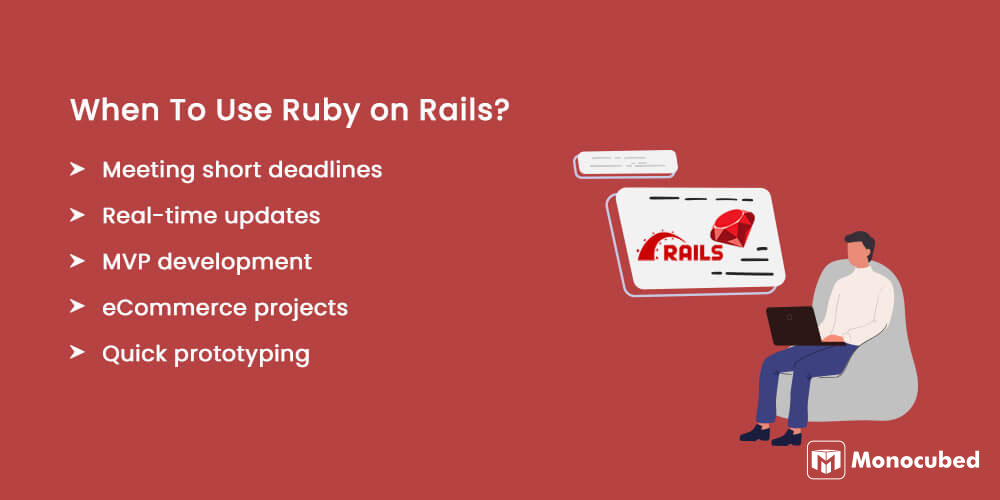
Now that we understand the difference between the two backend frameworks, let’s find out when to use it. With our experience as an RoR development company, we recommend using the Rails web framework in the following cases-
- When you have very short deadlines
- The project requires real-time updates and scalability after the website is live
- Development of Minimum Viable Products
- Startups and small businesses that require high scalability and performance
- Ecommerce projects with stability and security
- If you require quick prototyping
- When working with popular frontend frameworks and libraries such as Angular, React, or Vue.
- Complex projects that require unique features and functionalities
Where and When to Use Django?
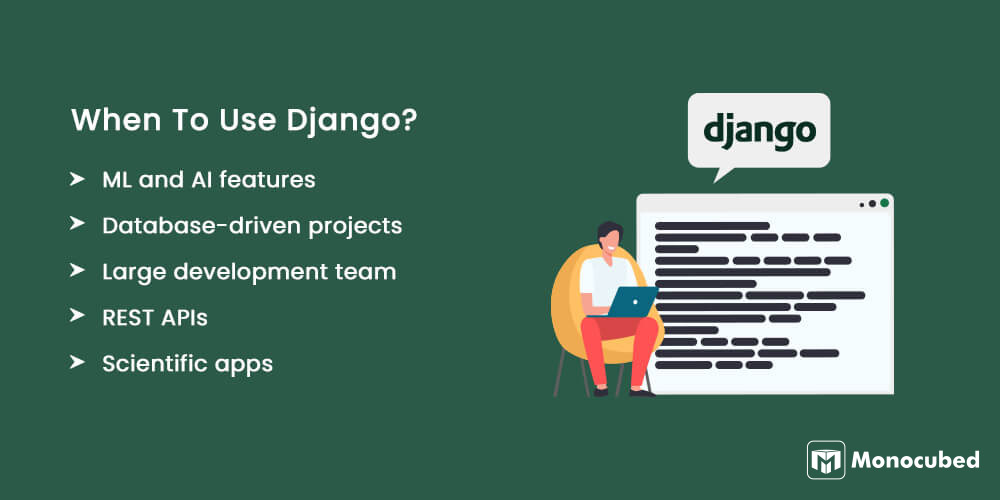
Top Python development companies like Monocubed, prefer Django for Python app development. But when comparing with the Rails framework, it is important to look at your requirements before choosing either.
We suggest you choose Django framework when developing-
- Complex database-driven websites -Django includes a perfect ORM for working with large databases
- Data visualization and analysis projects
- Projects requiring math-intensive, scientific programming
- Heavy user traffic web apps that require handling millions of user requests
- Rest APIs – You can develop RESTful apps using the Django REST framework
- Highly secure web apps that protect against common vulnerabilities automatically without writing any code such as cross-site scripting,
- Large projects with multiple team members – A large development team should prefer Django due to standardized coding practices.
- Modern web apps with new technologies such as Artificial Intelligence(AI) or Machine learning(ML)
Want to Amp Up Your Web App?
Use Django to take your web app idea to the next level with advanced AI features. Talk to our expert to validate your idea for free.
Django VS Ruby on Rails- Which One is Right for Your Requirements?
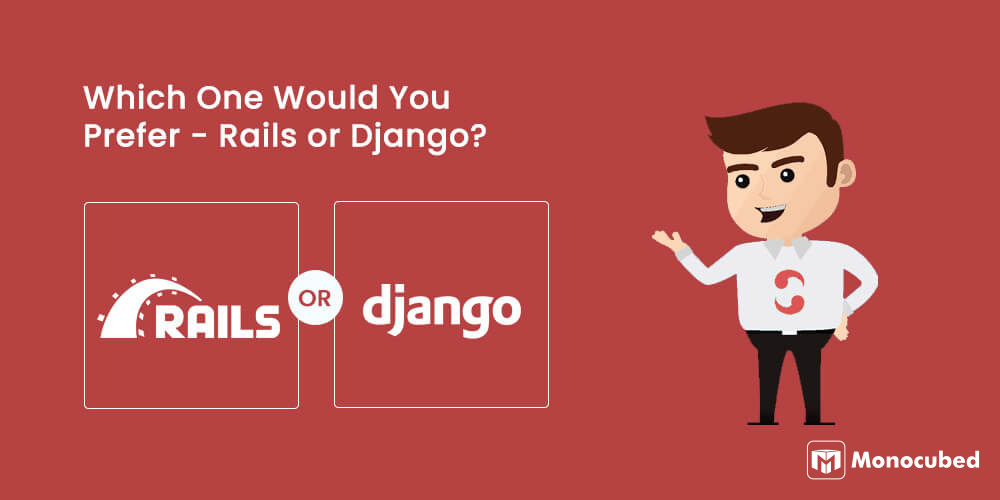
When it comes to Rails VS Django, although both are backend frameworks, they are suitable for different types of web projects.
Ruby on Rails is a better choice than Django for early-stage startups and small organizations. If your project requires a simple web application, Ruby on Rails is right for you.
Django, on the other hand, is better for large enterprises that require handling multiple databases and a more standardized, large-scale web application.
However when it comes to eCommerce projects, Ruby on Rails and Django are both popular web frameworks with excellent security measures. Rails performance and Django’s community support will help you decide between these popular web development frameworks.
Frequently Asked Questions
Our expert developers have answered some commonly asked questions. For any queries or information, feel free to contact us any time.
What are web development frameworks?
A web development framework is a software tool that is used for simplifying and streamlining the development of websites and web apps. A web application framework allows developers to develop customized web APIs. It offers the base for building and deploying web services, web applications and websites on the internet.
Which web framework to use – Django VS Rails?
Django and Rails are two of the best web development frameworks available for server-side web app development. Django is a Python framework used for building scalable, secure, highly performative web apps. Contrarily, Ruby on Rails is based on Ruby and is preferred for rapid development of MVPs, high-speed websites and web apps and quick prototyping.
Is Rails faster than Django?
Yes. Ruby on Rails is comparatively faster than Django. Django is based on Python, which is a slow language owing to its run-time compilation and dynamic typing. On top of this, the framework is packaged with a lot of functionalities and libraries that slow down the speed of Django. For instance, Instagram uses Django to power a high-traffic application that engages millions of users without affecting speed or performance.
Read our blog on in-depth comparison between Django and Node.js to find the key difference between the two backend technologies.
Conclusion
This Django vs Ruby on Rails blog closely compares the functionalities and features of both popular frameworks. In conclusion, although no framework is superior, you can choose the framework which is better suited to your project requirements.
Still, confused between RoR vs Django? Schedule a free consultation with our IT experts. Our developers are well-versed in Rails and Django, and can better guide you in finding the ideal fit.
 By Jeel Patel
By Jeel Patel
